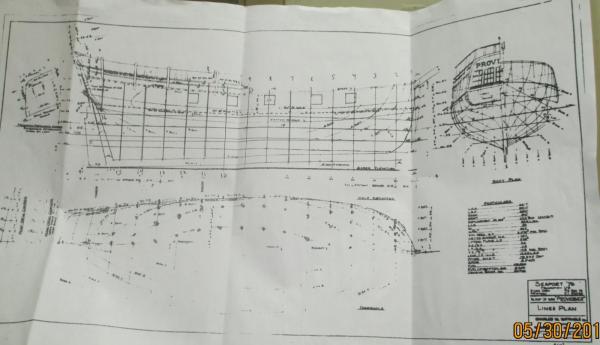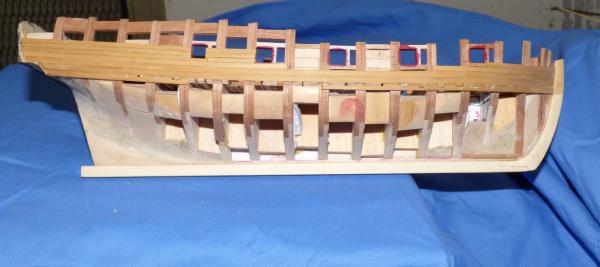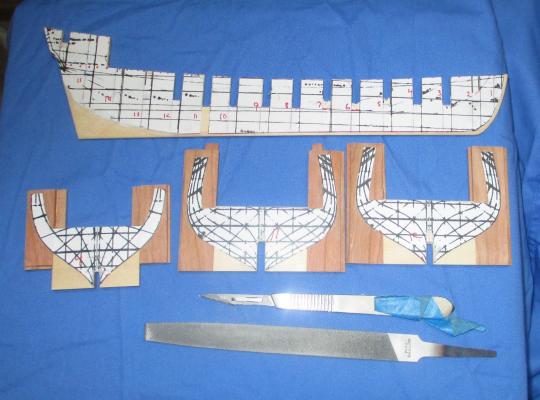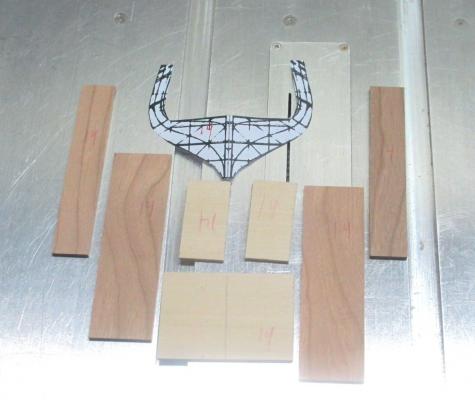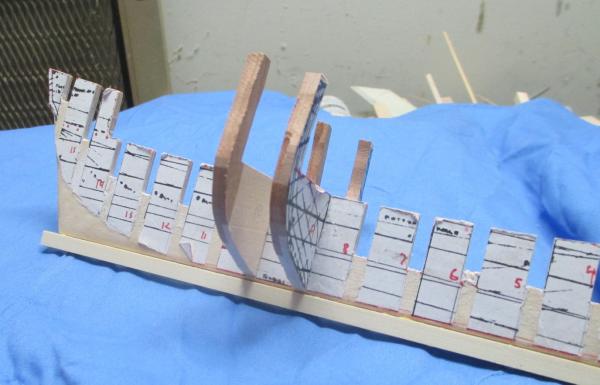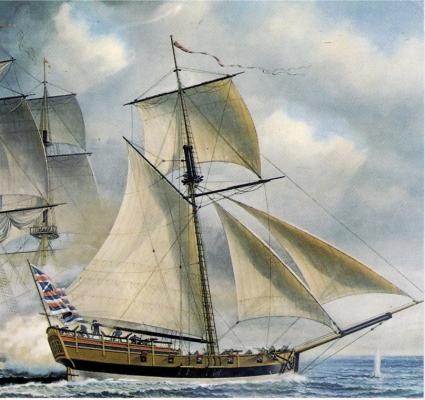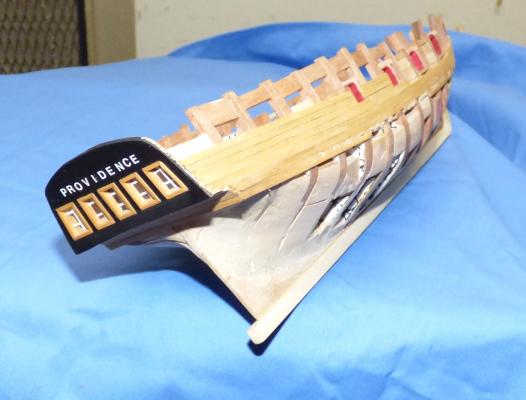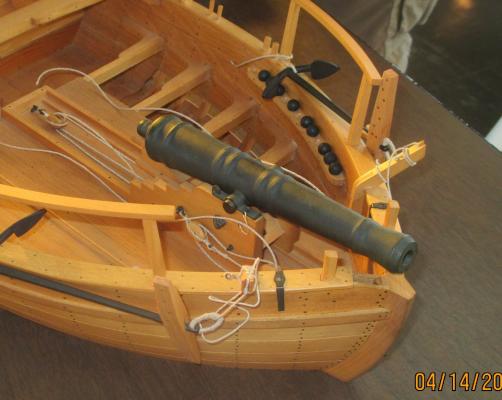-
Posts
1,876 -
Joined
-
Last visited
Content Type
Profiles
Forums
Gallery
Events
Everything posted by Chuck Seiler
-
SOS, You have stumbled upon a subject close to my heart. I am currently building the self-same PROVIDENCE from the same plans. I hope you will allow me to post my stuff...I have not started my build log yet. If you object, I will delete. I am using the same plans as you have, except I got them from the book "Valor Fore and Aft". I attempted to get permission to reproduce the plans, but there seems to be nobody left around to approve same. I scanned the plans in the book and took them to get blown up to the proper scale. I am building in 3/16" scale. The resulting plans are not that great. Some portions of the lines are missing or too light. Some lines are thicker than I would like. No worries. The sheer plan was used to make the center false keel/center support, while the body plan stations were used to make the bulkheads. I have previously tried to make these using modeling plywood, but it turned out to be a disaster. I ended up using basswood and cherry to laminate together a two ply bulkhead that is turning out to be quite strong. Here are the bulkheads being placed. The hull frames out. Planking started. ...and the transom. I am using this painting as inspiration. Once I get the hull completed, and the deck arrangements made, I will use the plans from Model Expo ARMED VIRGINIA SLOOP to fit out and set up masts and rigging.
-
Bob, SULTANA is a great model. It is sufficiently basic so as not to bog you down, but includes all the stuff you will eventually have to learn; planking, rigging, swearing and throwing things. I don't recall if Chuck's practicum discusses planking the hull, I believe it does, I know the original kit instructions do not. I would strongly recommend planking the wale (the thick planking right around the waterline) and above the wale. This part is a lot easier than the area below the wale and makes for a very nice model. I did this while leaving the area below unplanked but painted a cream white color. I am very happy with it. You can't go wrong following Chuck's practicum. I think you will enjoy the build.
- 44 replies
-
- Sultana
- Model Shipways
-
(and 2 more)
Tagged with:
-
Sam, There were several PHILLY builds going at the same time. Sometimes the discussions shifted from one to another. I believe I discussed both books in my log. I also covered them as well as "Benedict Arnold's Navy" in my scratch PHILLY build log. All excellent resources.
- 308 replies
-
- finished
- model shipways
-
(and 1 more)
Tagged with:
-

American sailing warships with no plans or records
Chuck Seiler replied to CharlieZardoz's topic in Nautical/Naval History
Dr. Clay Feldman is a master modeler in his own right and former owner/publisher of Ships in Scale. He has done work/research on Fair American as well. He has done extensive research into LEXINGTON. He has discussed the Davis model and why it is not correct. Several years ago (maybe 10, by now) when he first came out with the LEXINGTON model, he had an online information about the building...it was a group project. I believe most of that info is included in the Feldman package on LEX available from SiS. If you are interested in LEX, it is a must.- 401 replies
-
- John Adams
- Alliance
-
(and 3 more)
Tagged with:
-
Ken, What did you use to letter your transom?
- 481 replies
-
- rattlesnake
- model shipways
-
(and 1 more)
Tagged with:
-
Be sure to clean it up afterwards...a little wire brushing...some time in a vinegar bath.
- 308 replies
-
- finished
- model shipways
-
(and 1 more)
Tagged with:
-
I'd be happy to take the credit, but they are actually Sam's guns.
- 259 replies
-
- Gunboat
- Philadelphia
-
(and 1 more)
Tagged with:
-
I agree with those above that do the pencil method. For me, it provides a hint of color but is subtle. Living in San Diego I have the opportunity to see caulked deck planks on real sailing ships. Even at the distance I can get above them, which is about 6 or 8 scale inches, the caulking is not overwhelmingly dark.
-
Nenad, I disagree. If you have the opportunity to display it where people will see it, at least ONE other person will see it and say "Holy cow!!! Will you look at that!!!!" ...and that makes it doubly worthwhile, because that person will talk about it for years. "....I remember one time, I was looking at a ship model. The guy made actual working sheeves THIS SMALL."
-
Sam, Your swivel guns look great. I particularly like the brackets. Is that thingamajig in picture 3 the jig for making them? If you are a mind, I would be willing to send a few bucks in your general direction to purchase some of those guns. I will PM you on this.
- 259 replies
-
- Gunboat
- Philadelphia
-
(and 1 more)
Tagged with:
-
You can't go wrong with white. That was the common color on the Mississippi and Missouri.
-
Personally, I am a 'red snob'. I seldom like the red most people use...too bright in my opinion. I like the barn red or caboose red type color for internal bulwarks and appropriate deck furniture. I am currently experimenting with artist acrylics. Using "Windsor and Newton Galleria" paint, I mixed a large gob of crimson red and a wee dot of Mars Black...and alot of water. I am going for the consistency of olive oil for right now. I think I have the color I want. The secret (if, in fact, this works) is to start off with the gob or red and add VERY LITTLE dots of black until you get what you want...or what I want. Now, I will do a test paint to see what it looks like dry, on wood.
- 452 replies
-
- cheerful
- Syren Ship Model Company
-
(and 1 more)
Tagged with:
-
Speaking of Kurt....his article in the recent Ships in Scale is terrific. Excellent pics.
- 308 replies
-
- finished
- model shipways
-
(and 1 more)
Tagged with:
-
Small, yeah. One problem with cleats is/are that unlike some pieces of the model, they may have to take a strain....and will pop out. For Philly 1 I used some brass cleats from Blue Jacket. They are flat, but in that scale you don't notice. Also, they have a longer stem so they sink into the wood further. I used a glue, can't recall the name but I will get it. It is not quite an epoxy, but stronger than regular wood glue. For Philly 2 I am thinking of using some of Chuck P's wood cleats. The plan is to drill a small hole down the center and use a small dowel to give it more depth. I usually use bamboo, because you can get it real small and it is still strong. I turn it down with my dremel and sand paper.
- 308 replies
-
- finished
- model shipways
-
(and 1 more)
Tagged with:
-
As most have said or alluded to, in the end, it depends on what you are comfortable with. I, for one, will admit that I have omitted some details I originally intended on including because, try as I might, I couldn't get it looking very good. After numerous attempts I resolve to leave it off but try again will my skills improve (and/or I get better tools).
-
Better now than when you have the mast on. So, the catheads broke but the flimsey railing in the back didn't? Hmmmm.
- 308 replies
-
- finished
- model shipways
-
(and 1 more)
Tagged with:
-
Frankie, I disagree. I see no issue with including SOME detail at a certain granularity, but not include all. I suspect we already do that. If you rig a ship without sails, don't you leave off some of the rigging? Some people rig the guns to a gnat's ***, but do the really model in every rope, line, bucket, widget and who-ha that might be on deck?
-
All good points. I think that the better you get, the more detail you can put into your model. One reason for this is because you are getting better and can do things quicker. If it takes you forever to do the basic stuff, it will take several forevers to make it detailed. Secondly, when you get better your quality improves. Crappy details don't improve crappy models (trust me on that one). However when you have a quality model, quality details improve it. That having been said, there IS such thing as too much detail. I think scale dictates that. Sometimes you can overwhelm a model with too much detail. Personal preference. Take a step back and let the model tell you what is right. Who is your audience? If you are doing if for just yourself, make it for you. If you are making it for the public to see, remember people will only look at it for a few minutes, then go away. Some will look for 30 seconds some for 10 minutes. Make your model so it appeals to all of them in its own way. ...and whatever level of detail you decide upon, make ONE thing significantly more detailed. People will focus on that, you will get your "Holy Cow!!!" and people will walk away with a feeling it is far more detailed than it really is, because of the one they fixated on.
-
The Smithsonian 3D scan is of the ship as it is now. That includes all deterioration. Notice the gaps in the planking. . Above is a picture of Dave Yotter's PHILADELPHIA (taken from our recent ship model Guild meeting) built from the Smithsonian plans. Note how the curve of the caprail trends upward until it abruptly ends. That's where it was chopped off. You can that, if left in place, the operation of the forward gun would be impaired. Unlike the Model Expo plans, the Smithsonian plans are structurally correct. If you blow up the pic, you can see that the gap is indeed open and you can see into the innards. Kurt's replication is about the same. As previously discussed, they were not too concerned about water getting in there and rotting the insides out. They knew it would not be afloat long enough to worry about.
- 259 replies
-
- Gunboat
- Philadelphia
-
(and 1 more)
Tagged with:
About us
Modelshipworld - Advancing Ship Modeling through Research
SSL Secured
Your security is important for us so this Website is SSL-Secured
NRG Mailing Address
Nautical Research Guild
237 South Lincoln Street
Westmont IL, 60559-1917
Model Ship World ® and the MSW logo are Registered Trademarks, and belong to the Nautical Research Guild (United States Patent and Trademark Office: No. 6,929,264 & No. 6,929,274, registered Dec. 20, 2022)
Helpful Links
About the NRG
If you enjoy building ship models that are historically accurate as well as beautiful, then The Nautical Research Guild (NRG) is just right for you.
The Guild is a non-profit educational organization whose mission is to “Advance Ship Modeling Through Research”. We provide support to our members in their efforts to raise the quality of their model ships.
The Nautical Research Guild has published our world-renowned quarterly magazine, The Nautical Research Journal, since 1955. The pages of the Journal are full of articles by accomplished ship modelers who show you how they create those exquisite details on their models, and by maritime historians who show you the correct details to build. The Journal is available in both print and digital editions. Go to the NRG web site (www.thenrg.org) to download a complimentary digital copy of the Journal. The NRG also publishes plan sets, books and compilations of back issues of the Journal and the former Ships in Scale and Model Ship Builder magazines.

